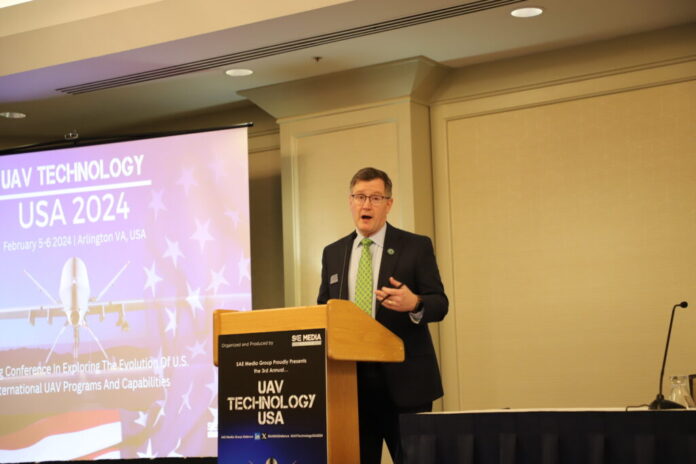UND hosted an event just a few blocks from the Pentagon — a conference at which government officials, industry representatives and academics gathered to discuss the role of unmanned aerial vehicles in national security and defense.
The third annual UAV Technology USA Conference – organized by the London-based SAE Media Group — has been hosted by UND each year since its inception, with President Andrew Armacost serving as chair for the second time. Last year, the event was chaired by Robert Kraus, dean of the John D. Odegard School of Aerospace Sciences.
Grand Forks ties
Armacost opened the conference by asking attendees to raise their hands if they have visited North Dakota and was pleasantly surprised by the number of hands in the air.
“Most people count it as the 50th state they visit, sometimes the 49th if they haven’t been to Alaska,” he joked. “It’s an amazing place. The pioneering spirit, and the incredible work ethic that exists across the state has yielded incredible research results and contributions to national defense.”
Among these contributions is the Northern Plains UAS Test Site, which in 2014 became the first of seven FAA-approved UAS test sites across the nation. This effort in turn spurred the creation of Vantis – a statewide network based in Grand Forks, tasked with developing Beyond Visual Line-of-Sight flights for UAS operators.
Armacost also cited defense contractor General Atomics Aeronautical Systems’ presence at Grand Sky as a “key training asset for our European partners.” At present, British, Italian, Dutch and Spanish pilots travel to Grand Forks to train on the company’s MQ-9 Reaper and MQ-9B SkyGuardian aircraft, housed in a newly inaugurated hangar.
Another sector with ties to Grand Forks that presented at the conference is U.S. Customs and Border Protection (CBP). The agency uses the Reaper to surveil both the Mexican and Canadian borders, with Grand Forks Air Force Base housing a fleet responsible for monitoring vast swaths of the latter – the longest international border in the world.
David Fulcher, director of air and marine operations at CBP’s National Air Security Operations Center in Grand Forks, said such surveillance is a vital asset in combatting illegal drug trafficking. He put the human cost of drug use in stark terms:
“If you crashed a (Boeing) 737 every day last year, you’d be 195 crashes short of the number of Americans killed from drug use,” he said. “We’re at the deadliest moment in the deadliest epidemic of drug use in American history. We’re trying to take the technology that many of you have developed for the war fight and use it in a way that we can protect Americans from the drug epidemic.”
Challenges Ahead
As the innovative arm of the U.S. Air Force, representatives from AFWERX stressed the need to be adaptable on the battlefield – citing recent conflicts as case studies. Lt. Col. Bryan Ralston, AFWERX integration lead, said even basic tools of communication and navigation cannot be taken for granted in today’s environment.
“As we recognize some of the lessons learned in the Russia-Ukraine conflict, GPS is not assured when we’re fighting a great power competition,” he said. “As we pivot toward the future, and how we might use small UAS in warfare, we recognize that will be a critical technology.”
Ralston’s colleague, Master Sgt. Donald Gansberger, software director for AFWERX Autonomy Prime, said a major remaining challenge in incorporating UAS into modern warfare is developing operating software that can be applied on a large scale.
“Looking at the U.S. commercial sector, that’s really where we lead the world as an information economy,” Gansberger said. “How do you leverage those successes and get them on to small, cheap, attritable platforms?”
Wes Shover, director of business development for Sagetech Avionics Inc., spoke of the importance of counter UAS in light of a drone strike that killed three U.S. service members in Jordan last month. A former Air Force joint terminal attack controller, Shover said the attack — the first time U.S. ground troops were killed in an aerial attack in 70 years — highlights the importance of employing air traffic control systems such as the Mode 5 IFF to distinguish between friend and foe in the UAS sphere.
“If you look at Jordan — and more than likely the future attacks that will occur — if the friendly aircraft was squawking mode 5, we would have been able to quickly determine which aircraft was hostile,” he said.
Reasons to visit
Armacost urged those unfamiliar with Grand Forks to visit, highlighting upcoming events including the Stratospheric Operations and Research Symposium (SOaRS), an event co-sponsored by NASA to be held March 12-13 at UND. Additionally, he cited the 18th annual UAS Summit and Expo — slated for Oct. 8-9, 2024 at the Alerus Center – as vital to the region’s ecosystem.
“What I’m painting for you is an ecosystem that is rather surprising,” Armacost said. “Most people think of Grand Forks as a faraway place. But in terms of its contributions to national security and defense, it’s quite significant. We hope that you would take an opportunity to come up and participate in the work that’s happening there.”
Accompanying Armacost to the conference were Mark Askelson, associate vice president for national security research, Ryan Adams, associate dean for national security, Scott Snyder, vice president of research and economic development and Naomi Hansen, director of communication and corporate partnerships.
In his closing remarks, Armacost reflected on the dynamism of the industry, and left attendees with three questions to ponder before next year’s event.
- Are open systems truly open?
- Can the acquisition process keep up with demand?
- Can we craft policy in the wake of massive technological change?
“Just looking at this conference versus two years ago, the pace of change has accelerated,” he said. “Undoubtedly between now and next year, the pace of change will continue to accelerate. I look forward to hearing about the progress that everybody is making based on what we heard at this conference.”




